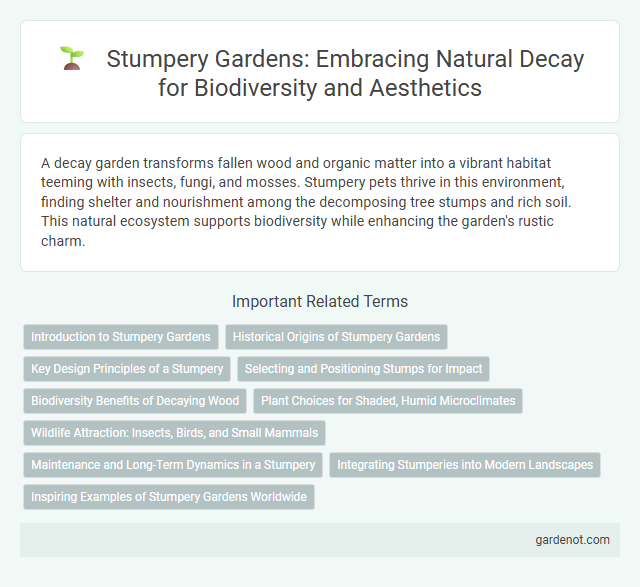A decay garden transforms fallen wood and organic matter into a vibrant habitat teeming with insects, fungi, and mosses. Stumpery pets thrive in this environment, finding shelter and nourishment among the decomposing tree stumps and rich soil. This natural ecosystem supports biodiversity while enhancing the garden's rustic charm.
Introduction to Stumpery Gardens
Stumpery gardens showcase the art of arranging tree stumps, roots, and other decayed wood to create a naturalistic, textured landscape. Emphasizing decay and organic forms, stumperies provide habitats for fungi, insects, and mosses, enhancing biodiversity. These gardens blend rustic aesthetics with ecological benefits, making them unique features in woodland or decay gardens.
Historical Origins of Stumpery Gardens
Stumpery gardens originated in Victorian England during the 19th century as a creative way to display tree stumps, roots, and moss combined with ferns and other shade-loving plants. These gardens were inspired by the fascination with natural history and gardening trends emphasizing rustic, naturalistic aesthetics. Early stumperies showcased botanical diversity while celebrating decay as an integral element of garden design.
Key Design Principles of a Stumpery
Decay gardens in stumperies emphasize organic decomposition, showcasing the natural beauty of rotting wood and leaf litter to create textured, evolving landscapes. Key design principles include layering various sizes and shapes of tree stumps, integrating mosses and fungi to highlight biodiversity, and arranging elements to mimic natural woodland habitats. This approach not only promotes ecological sustainability but also fosters a dynamic, visually rich environment that changes with seasonal decay processes.
Selecting and Positioning Stumps for Impact
Choose stumps with varied shapes and textures to create visual interest and contrast in a decay garden. Position larger stumps as central focal points while grouping smaller ones to mimic natural decomposition patterns. Incorporate moss and fungi around the bases to enhance authenticity and attract wildlife.
Biodiversity Benefits of Decaying Wood
Decay gardens, featuring stumperies, create vital habitats that enhance biodiversity by providing shelter and food for fungi, insects, and small mammals. Decaying wood supports diverse ecosystems, promoting nutrient cycling and soil health by breaking down organic matter and enriching the surrounding environment. These natural processes foster resilient habitats, increasing species richness and ecological balance in garden spaces.
Plant Choices for Shaded, Humid Microclimates
Shade-tolerant plants such as ferns, hostas, and mosses thrive in the humid microclimates typical of a decay garden within a stumpery. These species benefit from the moisture-retentive environment created by decaying wood, promoting lush, green growth. Incorporating shade-loving fungi and shade-tolerant groundcovers like ajuga further enhances biodiversity while supporting decomposition processes.
Wildlife Attraction: Insects, Birds, and Small Mammals
A decay garden, designed to simulate natural decomposition, creates an ideal habitat attracting diverse wildlife such as insects, birds, and small mammals. The rich, rotting wood and organic matter provide essential resources like shelter, food, and breeding sites for beetles, spiders, and various pollinators. Birds and small mammals benefit from the increased insect population and dense cover, enhancing biodiversity and ecosystem health within the stumpery environment.
Maintenance and Long-Term Dynamics in a Stumpery
Maintaining a stumpery involves regular monitoring of moisture levels and ensuring adequate drainage to prevent excessive rot while promoting fungal diversity essential for ecosystem health. Long-term dynamics include gradual wood decomposition that enriches soil nutrient content, supporting a diverse array of mosses, ferns, and invertebrates, which contribute to sustained biodiversity. Periodic removal of invasive species and re-stacking decayed logs help preserve structural integrity and aesthetic appeal over time.
Integrating Stumperies into Modern Landscapes
Integrating stumperies into modern landscapes enhances biodiversity by providing habitats for fungi, insects, and small mammals, supporting ecological health. These decay gardens blend naturalistic design with sustainable gardening, using decomposing tree stumps and logs to create textural contrast and seasonal interest. Emphasizing organic decay processes, stumperies reduce garden waste while enriching soil quality and promoting a balanced ecosystem.
Inspiring Examples of Stumpery Gardens Worldwide
Stumpery gardens showcase artistic arrangements of decayed wood and stumps to create unique natural sculptures that enhance woodland aesthetics. Notable examples include the Suzhou Stumpery in China, which integrates traditional Chinese garden design with intricate stump displays, and the Nyewood Stumpery in England, renowned for its lush moss and fern plantings around weathered roots. These inspiring stumperies demonstrate how decay gardens promote biodiversity while offering enchanting spaces for nature lovers and gardeners.
Decay garden Infographic

 gardenot.com
gardenot.com